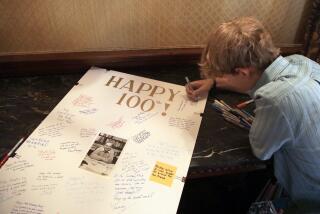A Clearcut Miracle Man
- Share via
BALTIMORE — Narine Baney taps softly on a beaker with his knuckle, then lights his torch. Seconds later, the jagged lip of the clear glass goblet shatters in the flame, and its delicate reconstruction gets underway.
In a cluttered corner of the chemistry and physics building at the University of Maryland at Catonsville, Baney is known as the miracle man. To the rest of the world he is a glassblower.
He is skilled in an old-fashioned art form capable of mesmerizing the layman--and maintaining vital equipment for 70 scientists at the university and their research projects.
Many laboratories spend thousands of dollars on breakable glass equipment, but the university and a sister campus have glassblowers on their staffs who work to save beakers and budgets.
The craft of glassblowing is vital to science, especially when researchers design experiments for which no containers are available.
Glassblowers make custom tubing, beakers and jars for work on “the inventive side of science,” says Thomas Reddy of the American Scientific Glassblowers Society in St. Paul, Minn.
One of nearly 1,000 scientific glassblowers across the United States, Baney has had a 22-year tenure at the Maryland university that makes him the state’s dean of the blowtorch.
At age 69, the Trinidad native could retire, but he remains a part-timer at the university and helps contribute to its scientific research, which last year topped $35 million.
“My research would not be possible without his presence,” says Ted Budzichowski, a chemistry professor who calls on his buddy, the “Baney Man,” daily to repair shattered tubes and beakers.
Budzichowski estimates that Baney’s talents save him thousands of dollars each year and countless hours after a mishap.
The chemist once did a sketch for an intricate glass gas line to be used in an experiment on the purification of gases and sent it to Baney to create. The line was delivered and today is a research masterpiece--it includes a tiny bump in one glass tube that actually was a mistake in Budzichowski’s drawing.
“He’s the best I’ve come across,” Budzichowski says. “If something breaks, you don’t have to wait two or three weeks for it to be repaired, and we don’t have to buy three of everything so we’ll have a backup. He’s vital.”
Baney learned how to blow glass in 1945 while a teenager in Trinidad. He was seeking a skill to allow him to escape an impoverished background. What he got was a slice of the American dream.
His craft led him to a career in the United States, U.S. citizenship in 1976, enough capital to invest in real estate and a good life for his wife and six children, 12 grandchildren and two great-grandchildren.
“To be honest, I feel like a prince--I never had anything, and now I have so much,” he says. “I just fell into glassblowing--it was an accident. I needed a job. I’ve never said how good I am, but I’ve met the people that are the best, and I’m nearly as good as they are.”
Glassblowing, Baney says, requires patience, skill, steady hands and evenly blown breaths that mold the hot, softened glass as it is repaired.
“When you do a good job and the chemist is satisfied, it makes me feel satisfied too,” he says. “I’ve reached the stage where I’m quite confident in my work.”
Catherine Fenselau, professor and chairwoman of the university’s chemistry and biochemistry department, says Baney saves the department up to 50% of the replacement value of supplies--as much as $120 for a large beaker--by repairing the equipment. He also works for other university departments and other campuses in the University of Maryland system.
“He’s a wonderful human being, generous and warm, and his work is a real art,” Fenselau says. “He’s a master of it. I often get letters from people praising his skills and his product. The custom work he does saves us money, and the quality of the work is impossibly hard to get elsewhere.”
Through it all, Baney remains humble and always has a smile and time to chitchat for those who visit.
“He’s very sincere,” says Lisa Kelly, a scientist who has tapped Baney’s skills in her quest to study how lasers might one day be used to kill the cells of a cancerous tumor. “He loves his work, and it reflects in the quality of work that he does and the time he does it in. He’s an invaluable resource to the university.”






